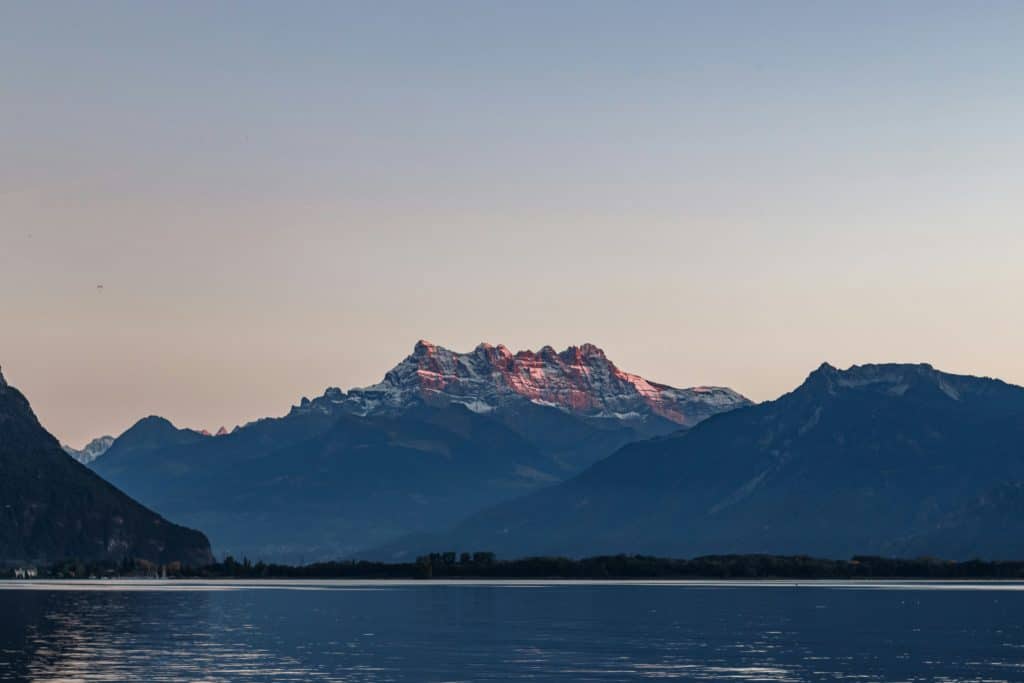So what are these 𝗺𝘂𝗿𝘀 𝗶𝗺𝗺𝗲𝗿𝗴𝗲́𝘀 that can be seen in Geneva not far from the banks of Cologny, Le Reposoir or Le Vengeron? They are veritable flooded architectural constructions, forming sublacustrine landscapes worthy of a true-to-life Atlantis!
However, these are not the remains of dwellings, but the remains of 𝗰𝗮𝗿𝗿𝗶𝗲̀𝗿𝗲𝘀 𝗱'𝗲𝘅𝗽𝗹𝗼𝗶𝘁𝗮𝘁𝗶𝗼𝗻 an exceptional stone: 𝗹𝗮 𝗺𝗼𝗹𝗮𝘀𝘀𝗲. Indeed, from the 14th to the 18th century, this stone was quarried in abundance because, 𝗿𝗲́𝗽𝘂𝘁𝗲́𝗲 𝗽𝗼𝘂𝗿 𝘀𝗮 𝘀𝗶𝗺𝗽𝗹𝗶𝗰𝗶𝘁𝗲́ 𝗱𝗲 𝘁𝗿𝗮𝘃𝗮𝗶𝗹 𝗲𝘁 𝘀𝗮 𝗳𝗮𝗰𝗶𝗹𝗶𝘁𝗲́ 𝗱'𝗮𝗰𝗰𝗲̀𝘀, it was used extensively in large-scale projects such as the 𝗺𝗮𝗶𝘀𝗼𝗻 𝗧𝗮𝘃𝗲𝗹, 𝗹𝗮 𝗖𝗮𝘁𝗵𝗲́𝗱𝗿𝗮𝗹𝗲 𝗦𝘁-𝗣𝗶𝗲𝗿𝗿𝗲 𝗼𝘂 𝗲𝗻𝗰𝗼𝗿𝗲 𝗹'𝗛𝗼̂𝘁𝗲𝗹-𝗱𝗲-𝗩𝗶𝗹𝗹𝗲.

On the other hand, the extraction technique was no picnic.
At the time, extraction only took place 𝗾𝘂𝗲𝗹𝗾𝘂𝗲𝘀 𝗺𝗼𝗶𝘀 𝗽𝗮𝗿 𝗮𝗻 𝗽𝗲𝗻𝗱𝗮𝗻𝘁 𝗹'𝗵𝗶𝘃𝗲𝗿, period during which the lake level could 𝗯𝗮𝗶𝘀𝘀𝗲𝗿 𝗷𝘂𝘀𝗾𝘂'𝗮̀ 𝟯 𝗺𝗲̀𝘁𝗿𝗲𝘀, making the coveted rock accessible.
The quarrymen's work consisted of isolating the quarrying area, drawing water from within the area, sawing pits up to 3 metres deep and then 𝗱𝗲́𝗰𝗼𝘂𝗽𝗲𝗿 𝗱𝗲𝘀 𝗯𝗹𝗼𝗰𝘀 𝘀𝘂𝗿 𝗺𝗲𝘀𝘂𝗿𝗲 into the stone, depending on demand. We can then imagine the 𝘁𝗿𝗮𝘃𝗮𝗶𝗹 𝗽𝗲́𝗻𝗶𝗯𝗹𝗲 that these workers on Lake Geneva had to perform, in the piercing cold of winter and the dampness of the lake.
Nowadays, these submerged lake workings offer a backdrop that is certainly immobile, but rich with all the history that makes them up, demonstrating once again 𝗹'𝗶𝗺𝗽𝗼𝗿𝘁𝗮𝗻𝗰𝗲 𝗱𝘂 𝗟𝗲́𝗺𝗮𝗻 𝗱𝗮𝗻𝘀 𝘀𝗲𝘀 𝘂𝘀𝗮𝗴𝗲𝘀 𝗾𝘂𝗼𝘁𝗶𝗱𝗶𝗲𝗻𝘀 𝗽𝗮𝗿 𝗹'𝗛𝘂𝗺𝗮𝗶𝗻, and have been for centuries.
Photo credits: Kai Taimsalu
𝐒𝐨𝐮𝐫𝐜𝐞𝐬 :


